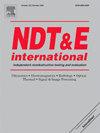Method for in-situ monitoring of corrosion in aluminum joints under Electrical Impedance Spectroscopy using a carbon nanotube-doped adhesive
IF 4.1
2区 材料科学
Q1 MATERIALS SCIENCE, CHARACTERIZATION & TESTING
引用次数: 0
Abstract
A novel monitoring technique based on in-situ electrical impedance measurements is proposed for the analysis of the corrosion process in bonded Al-Al joints. For the application of this technique, the adhesive is modified by embedding a carbon nanotube (CNT) dispersion able to generate an electrical percolation network. A correlation between the electrical response and the evolution of the corrosion of the adherents is investigated when the joints are immersed in a 3.5 wt% NaCl aqueous solution. It has been observed that the electrical behavior of the adhesive joint can be modeled by a series of resistance-capacitance (RC) and inductance-resistance-capacitance (LRC) elements. More specifically, the initial interface can be modeled with parallel RC elements. However, the ideal capacitive behavior of the interfaces becomes non-ideal when the immersion time increases, and the corrosion mechanism takes place at the interfaces. For short immersion times, the joint can be modeled by a Constant Phase Element (CPE), due to the formation of an Al2O3 layer and corrosion products, that promote a higher energy scattering. At longer immersion times the formation of spalled Al is observed, and the electrical model requires the inclusion of an additional R-CPE element within the interface, proving great potential for the in-situ evaluation of corrosion in such complex elements.
掺杂碳纳米管胶粘剂对铝接头腐蚀的电阻抗光谱原位监测方法
提出了一种基于原位电阻抗测量的新型监测技术,用于分析铝铝焊接接头的腐蚀过程。对于该技术的应用,通过嵌入能够产生电渗透网络的碳纳米管(CNT)分散体来修饰粘合剂。研究了接头浸泡在3.5 wt% NaCl水溶液中的电响应与附着体腐蚀演变的关系。结果表明,粘接接头的电学行为可以用一系列电阻-电容(RC)和电感-电阻-电容(LRC)元件来模拟。更具体地说,初始界面可以用并行RC元素建模。然而,随着浸泡时间的增加,界面的理想电容行为变得不理想,并且在界面处发生腐蚀机制。在较短的浸泡时间内,由于形成了Al2O3层和腐蚀产物,促进了更高的能量散射,因此可以用恒相元(CPE)来模拟接头。在较长的浸泡时间内,可以观察到剥落Al的形成,并且电模型需要在界面内包含额外的R-CPE元素,这证明了在这种复杂元素中进行腐蚀现场评估的巨大潜力。
本文章由计算机程序翻译,如有差异,请以英文原文为准。
求助全文
约1分钟内获得全文
求助全文
来源期刊

Ndt & E International
工程技术-材料科学:表征与测试
CiteScore
7.20
自引率
9.50%
发文量
121
审稿时长
55 days
期刊介绍:
NDT&E international publishes peer-reviewed results of original research and development in all categories of the fields of nondestructive testing and evaluation including ultrasonics, electromagnetics, radiography, optical and thermal methods. In addition to traditional NDE topics, the emerging technology area of inspection of civil structures and materials is also emphasized. The journal publishes original papers on research and development of new inspection techniques and methods, as well as on novel and innovative applications of established methods. Papers on NDE sensors and their applications both for inspection and process control, as well as papers describing novel NDE systems for structural health monitoring and their performance in industrial settings are also considered. Other regular features include international news, new equipment and a calendar of forthcoming worldwide meetings. This journal is listed in Current Contents.
 求助内容:
求助内容: 应助结果提醒方式:
应助结果提醒方式:


